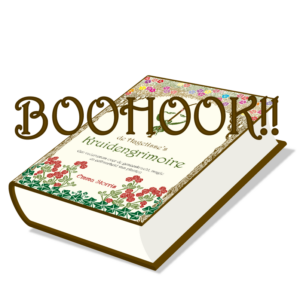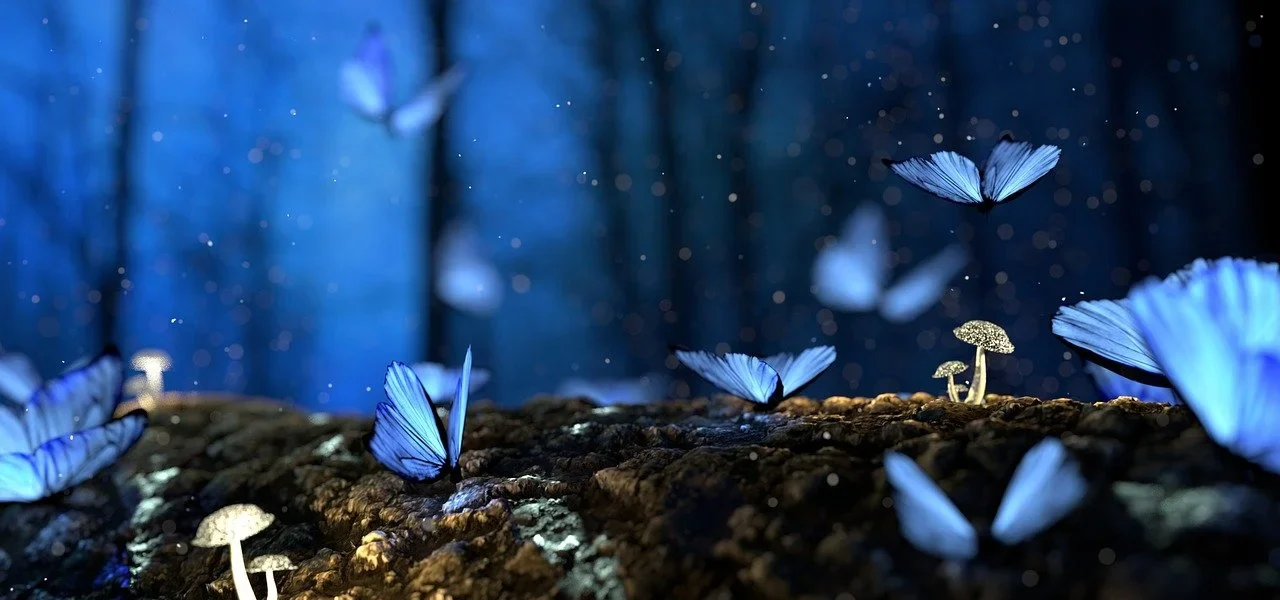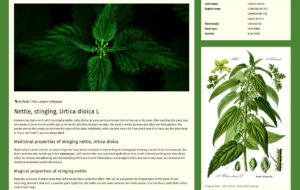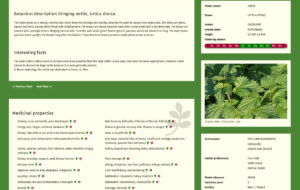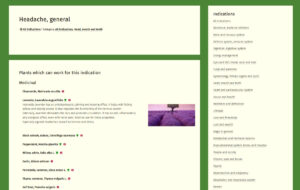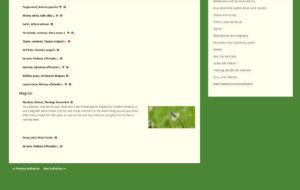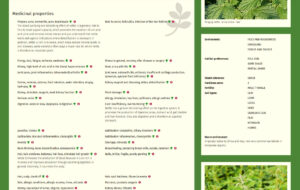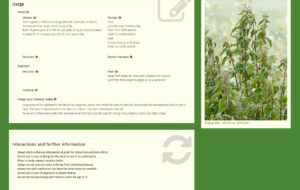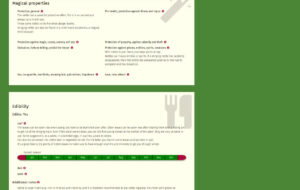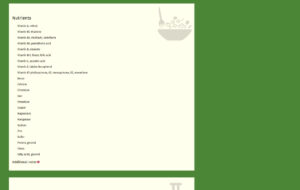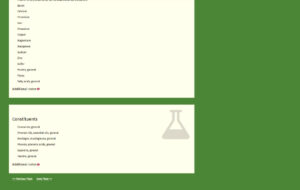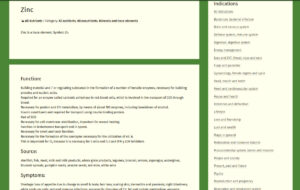Vademecum manual
In the hagetisse plant vademecum you will find a wealth of information regarding all kinds of herbs, flowers, plants and trees and, related to that, indications, medicinal and healing properties, magical properties and the likes. This vademecum, which is basically a plant handbook, is a work in progress, so information will be added regularly. This document is intended to be a manual in the use of this reference work on medicinal, magical and edible plants.
First of all… (very important, do not continue without having read this part)
- Membership gives you access to the information provided in the vademecum for personal use, but you are not allowed to copy the content or any part of the database.
- As a member you will be added to my mailing list so I can keep you up to date on new publications etcetera.
- This vademecum is made by a human, being me. I can make a mistake. Therefore, always use your common sense. Use of the information in the vademecum is always for your own risk and account.
- The world of medicine is always evolving. Insights are gained daily. Therefore, in each plant monograph it is stated that you should read a pharmacotherapeutical manual. In such a manual instructional information per type and brand of medication is detailed. Interactions with herbs aren’t always properly documented though. If you suffer from illnesses and/or use medication and/or other herbs and you do not know VERY certain if these can be combined with a plant you want to use, always investigate THOROUGHLY whether that’s a good idea, even if it’s not mentioned in a plant monograph.
- Never use more that the dosage indicated, unless at the advice of a medical professional. Therapeutically plants are always used in fairly small amounts. If you, all of a sudden, see a unusually high dosage, check and double check this. I could have made a mistake. Please inform me about any such discrepancy as well. If you purchase a phytotherapeutical which contains a certain plant and the dosage that is indicated for that phytotherapeutical differs from the dosage as mentioned in a plant monograph, use the dosage as indicated in the instruction of the phytotherapeutical. It might be that the standardisation of this phytotherapeutical is different from the traditional one.
- Never use a plant of which you don’t know whether you are overly sensitive to it. If you’re not absolutely sure, always try a tiny amount first.
- If you harvest your plants yourself, whether in the wild or from your garden, make sure you’ve got the right plant.
How does the vademecum work? Manual for this work on medicinal, magical and edible plants
On the website, choose the menu Vademecum to go to the vademecum start page. You can always return to this page by clicking the Start button. On this page you’ll see plant tiles. Clicking anywhere on one of those tiles will take you to the plant monograph. On this page the plants are listed in order of publishing . The last plant I have created or updated is therefore at the top. By going to this page you will always see the very latest additions to the vademecum.
You can enter the vademecum in various ways. Do you want to know something about a specific plant? Then enter the vademecum via the Plants button or menu option. On this page you will find the plants in alphabetical order, using the English name. Do you want to search by means of the Latin name of a plant? Then click on the label icon behind the title Plants. Categories will now come into view. With those categories you can search on the plant family to which a plant belongs and on the first letter of both the Dutch and the Latin name.
All roads lead to a medicinal, magical, edible plant
Do you not know which plant you would like to use and do you want to search for a condition or purpose? This can be done via the Indications button or menu option. There you will also find the label icon behind the title. Click on it and you’ll see the main groups you can search for. You can also access the information in the vademecum via the main menu at the top of the website, in the drop-down menu under Vademecum.
Whichever road you take, you will end up on a plant page with a plant monograph on it. This means that you can find information about the characteristics of a plant, what it looks like, where it likes to grow, what its medicinal properties are, what you can do with it magically and whether you can eat it and how.
Step by step through a monograph
Below you’ll find screenshots of the nettle monograph. I will use this plant to briefly explain how a monograph works. Mind you, I continuously process new knowledge and experiences with a plant in the vademecum, so it may be that, in the meantime, there is even more info on the nettle. But at least you’ll get an idea what to expect. Click on the screenshots to enlarge them.
The monograph starts with a general introduction. If you are not logged in, you will still see this part. The rest of the monograph is still hidden. You have to log in or, if you are not yet a member, register to see the rest. When you have read this part you will know a few interesting things about the nettle, but only behind closed doors we will dive in deep.
Botanical description and interesting facts
When you scroll a little further you can read what the plant looks like. The monograph also always contains several images to support this. The Interesting facts department usually contain some fun facts. On the right you see information about the plant’s botanical characteristics. The year bar you see there will return in several places and clearly indicates when this characteristic applies. In this case, the bar gives information about the time the nettle blooms, which is from June to October.
Medicinal properties
Now we come to the first part of the information most of you are interested in: the medicinal properties of the plant. As you can see there are lines with keywords. These are indications. You can also access them via the Indications button in the bar at the top of the vademecum or through the Indications menu option in the main menu. But the indications a plant works for can also be accessed directly from this section by clicking on them. On each indication page you will then see a list of the plants that can be used for it. By clicking on those plants you will immediately go to the relevant plant monograph. See below for an example of an indication.
Back to the plant monograph: behind the indications you see symbols, a green cup and an i in a red circle. You always see the latter, the former sometimes. The cup means that this is a top plant for this indication. For each indication there are plants that you can use, but not all of them are equally powerful. This way you can see which plants are extra useful for an indication. Thus you can make informed choices based on your focus and goals.
How the i’s work
Throughout the website, the red circle with the i-sign means that there is more information. An i is shown only if there actually is extra info to be had. Click on this symbol to make the information visible. Below you can see what that looks like. I only opened a few i’s in this example to keep it overseeable. But, as said, behind every single i offers hidden knowledge.
Below the indication belonging to the i you clicked, you now see a piece of text which briefly explains why this plant works for this indication. This is very useful if you know into which process involved in an indication you want to work on. In general, if external is mentioned the information is meant for external use, if it says internal and external both are possible, and if nothing is mentioned the information is meant for internal use.
On the right you see the top of a tile with information about how this plant grows. For those of you who, like me, like to grow plants yourself, it is useful to know what a plant needs. You can find it here. This part is a lot bigger than you can see in this picture. You’ll see the rest on the right in the following image. Note: the hardiness zone indicated uses the USDA system because this takes more growth aspects into account than the British system does.
And how do you use that plant?
Nice to know what you can do with a plant, but you probably want to know how as well. Now, you can of course just buy a phytotherapeutic supplement in a store, but as a hagetisse I want to be able to make things myself. And I assume that you want that too. If so, you can find it here. I have only included uses which you can make yourself in a well-equipped kitchen. So you will not find recipes here for, for instance, standardised nebulisates, because most people really cannot freeze dry at home.
I have also written blogs about how to make a tinctures, oils, ointments and so on yourself. So if you don’t know that yet… you can find it on this site. At the bottom of this part you will find the field Interactions and other information. Here you will find any warnings and other things to look out for with regard to this plant. Note: always check for interactions and side effects yourself. Plant knowledge is still growing every day and you cannot be too careful.
Magical properties
Underneath this section you’ll find the Magical properties section, where you can find information on how to use this plant magically. Importantly, if a plant can be used medicinally, it can be used magically for that same purpose as well, i.e. in a talisman, amulet, poppet, jar, for burning during rituals, etcetera. In most cases I do not mention the indications which I have discussed in the Medical properties section again. Only if there is a specific, unusual way to use a plant magically, will I mention an indication twice.
Magical effects are often sympathetic, that is to say that the magical effects are related to the properties of the plant as people perceived it. Most of what I’ve written down here concerns local magic and local means the part of the world that I come from, Europe and especially the north-west. This doesn’t mean it isn’t relevant for other parts of the world, since magic often turns out to be the same all over. Besides, when travelling to unknown parts of the world, European settlers often took their magic with them. Historical evidence can be found for the majority of the effects listed here. The rest stems from folk tradition.
I did often remove the Christian “translation”. Much of our knowledge of our traditions we have thanks to records, written down by Christian writers. That’s great, but what is less great is that they often christianised the magic. Usually, however, it’s fairly easy to reconstruct what our magical tradition would have looked like without ecclesiastical interference.
Edibility
Straight after Magical purposes you’ll find the Edibility section. Whether a plant is edible or not is indicated here. It also states which parts are edible and, per part, what you can do with it. Most people are amazed at all the plants in their surroundings which turn out to be edible. Take my garden. Admittedly, it is a bit wild and therefore it may contain more than in the average Dutch garden, but in my garden alone there are no fewer than 30 edible plants.
Constituents and nutrients
For the fanatics among you I have also included constituents and nutrients.
This part is by no means complete, which is hardly feasible. But the main categories of constituents and nutrients can be found there and will tell you a few things about what a plant can do.
Here, too, the lines are clickable. For example, if you click Zinc in nettle, you will go to the page about zinc. There you will find the following:
And, as with Indications, you will also find matching plants on these constituent or nutrient pages. By clicking on those plants you will go straight to the relevant plant monograph. Again, this part is not complete as this isn’t feasible. But you will find the essentials here.
Extra blogs and pages
Apart from the hidden part of the vademecum, there is more hidden content on the hagetisse website. I already mentioned the blogs about making tinctures, ointments, oils and related products. But there’s more. In addition to access to the vademecum, your membership also gives you access to that content. The level of access depends on your type of membership.
Search and find
The website also has very useful search functionality. You can get there by clicking on the magnifying glass to the right in the topmenu. Here you can specify in detail what type of entry you are looking for. I’d say: look around and try it out. If you cannot find information of which you have reason to think should be available on my site, please check the FAQs first. Is the answer not there? Please do not hesitate to contact me.
Become a member
Much of the vademecum is behind a member login. Becoming a basic member is free and for a small yearly contribution you’re a paid member. You can become a member via the Become a member page.
